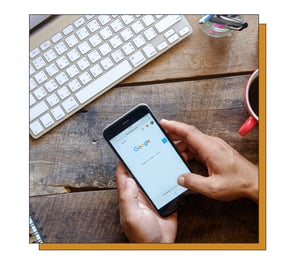BLOG Guide to Inbound Marketing Channels
Guide to Inbound Marketing Channels
POSTED BY Primitive | Jun 26, 2020

Inbound marketing can most easily be likened to a mutually beneficial conversation between strangers, in the hopes the relationship flows from strangers to acquaintances to life long friends.
But just like in the real world, going from strangers to best pals takes effort and a lot of building trust.
So, how does a small, medium, or large business bridge the gap in an increasingly low touch world? Inbound marketing channels.
The three stages of inbound marketing
Before diving into the different channels available for an inbound marketer to use within their digital marketing strategy, it makes sense first to uncover the three different stages and their main objectives.
Attract –  This stage is where the better majority of your visitors are first introduced to you and become aware of both your brand as well as your brand’s offerings. This stage is mostly led by your marketing team.
This stage is where the better majority of your visitors are first introduced to you and become aware of both your brand as well as your brand’s offerings. This stage is mostly led by your marketing team.
Convert – This stage, also known as the Engage stage, serves as the moment in which your organization aims to build a deeper relationship with your potential clients while simultaneously compounding on existing brand trust. This stage is primarily driven by a partnership between your sales and marketing teams.
Delight – This stage exposes your company’s ability to sustain brand trust for a customer’s lifetime value (LTV). Although this stage might seem to be one your team can set to “autopilot,” it’s arguably one of the most critical stages and serves as a catapult for which your company’s longevity is based.
Types of Channels
It’s important to remember that inbound marketing isn’t meant to simply generate traffic. Instead, inbound marketing is meant to generate qualified traffic to your website by drawing your target audience in with relevant and high-quality content.
Taking the time to research your company’s buyer personas helps pinpoint your target audience’s pain points, obstacles, objections, challenges, and goals. All of this information proves helpful in understanding your target audience, narrowing your messaging, and determining the best channel to reach them.
Attract: website, blogging, videos, podcasts, SEO, and social media
Blogs optimized with keywords and long-tail phrases prime themselves to be searched and indexed by search engine crawlers or spiders.
The crawling performed by search engines, like Google, serves as a way to either validate or invalidate the credibility of a page’s content while also promoting that content based on relevance to a user’s query.
Convert: long form content, Call-To-Actions, and landing pages
After the Attract stage comes the Convert stage. At this point, your company wants to position itself as a center for high-value information.
A direct result of having this targeted content is the willingness of your website visitors to engage in an exchange: personal information (name, email, phone, etc.) for gated content. As a prospect provides more contact information, your company can increase the value or personalization of the content provided.
Forms, CTAs, and landing pages are three well-utilized ways to gather and obtain personal data (currency for marketers) on prospects in exchange for more refined, personalized, or even specialized content.
With so many individuals holding ownership over at least one email address (potentially more if an individual also has a business email), this barrier of entry for a prospect is low. At the same time, however, the value is exceptionally high.
Delight: email and social media
Turning customers into brand advocates and lifetime consumers of your offerings is one of the most vital aspects of the Delight stage.
There’s a delightfully (see what we did there?) funny scene in season two of the American version of The Office where Junior Salesman Ryan Howard states he has been attending business school at night.
Ryan’s boss, Michael Scott (who has never been to business school), in an attempt to boast of his own business savvy, asks Ryan to quiz him on fundamental business questions. At the same time, colleague Dwight Schrute, periodically involves himself as well. The conversation looks a little like this:
Ryan: Is it cheaper to sign a new customer, or to keep an existing customer?
Dwight: Keep an existing…
Michael: [to Dwight] Shut, it. Can I… can I just do it, please? [to Ryan] Uh, it’s equal.
Ryan: It is ten times more expensive to sign a new customer.
Michael: Okay. Yes! It was a trick question.
To Ryan’s point, statistics tell us acquiring new customers is becoming increasingly difficult. If all has gone well through the previous stages, your company should have a robust foundation of content that directly benefits your clients and their needs.
One of the best mindsets to have when aiming to delight your customers is to respond to any inquiries with speed and intentionality. Engaging with clients through social media channels and strategically timed emails are two ways to monitor the conversations that matter most to your target audience, while continuously giving your brand an advantage to your industry’s needs.
By continuously embracing and nurturing your existing clients, your business gives your customers a reason to come back to you, while also sharing your brand’s benefits with friends, family, colleagues, and more.
Inbound marketing, as a whole, carries a wealth of benefits for any digital marketing team. Dissecting the umbrella a bit further uncovers how various channels can be used to maximize your brand reach which serves to boost conversions and company growth.
Eager to uncover the strategy that leverages technology with growth? Schedule your free consultation today.
SHARE THIS POST:

About the writer, Primitive
The team behind On the Dot. is made up of creatives, strategists, and developers who give a damn. At Primitive, we craft digital solutions that help businesses grow from brand to backend. Every insight we share is backed by strategy, driven by results, and built to move your business forward.